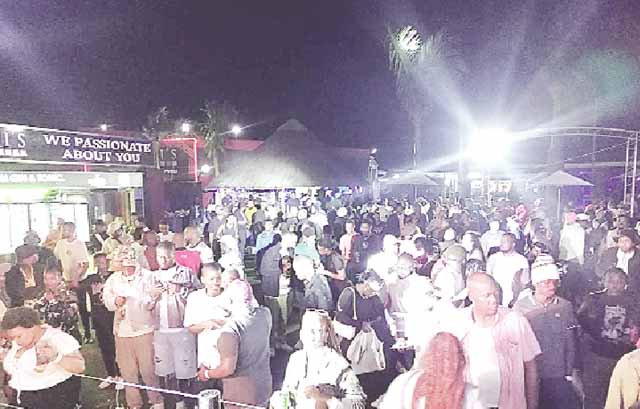By Zwelethu Dlamini | 2020-11-20

WHILE it may seem that people will be voting for either Donald Trump or Joe Biden as their president this is not the case.
According to University of New Mexico Political Science lecturer, Dr. Lonna Atkeson in the US Constitution and in federal law, US citizens have no federal constitutional right to vote for president or vice president, instead they vote for presidential electors, which is the Electoral College.
The professor was speaking during the Foreign Press Centre Virtual Reporting Tour on ‘Electoral College’ with journalists on Monday where she discussed the mechanics of the Electoral College.
“Basically, in the US Constitution and in federal law, we have no federal constitutional right to vote for president or vice president, instead we vote for presidential electors.
There is only one state where the right of the people to vote for presidential electors is guaranteed by the state constitution, and that’s the great state of Colorado.
And in 1876, they passed a law that said that the electors shall be chosen directly by the people. But in fact, in most states, of course, that is how the electors are selected, but it is the right of the legislators to take that away,” she said.
The professor then explained how the Electoral College is formed, how they are elected and how they elect the president as detailed below:
HOW MANY ELECTORS ARE THERE?
Electoral College representation is equal to congressional representation. Therefore, each state is guar- anteed at least three electoral votes, two for their Senate and one for the House.
So, we can think of this institution as both proportional and federal. Each decennial census, the Congress adjusts the congressional representation for each state.
So, states lose and gain representation. Of course, in between census, there is no accounting for the shifts in population. And, for example, 1990 estimates were used for every election until 2004. And that happens over time where we see these extended estimates for the decennial census being used.
That’s the Electoral College, always over or underrepresenting some states because populations are always moving.
And just as an example, California population in 1988 translated to 54 Electoral College votes, but it only received 47.
So, obviously as we move through the decennial time, the difference in population is going to translate into bigger differences.
WHO NOMINATES THE ELECTORS?
The most common procedure is state conventions of political parties. The second most common are State Party Central Committees making the nominations and these happen during the year of the presidential election. The most unusual is Pennsylvania, which authorizes each party’s presidential nominee to select electors on its behalf.
WHO ARE THE ELECTORS?
Well, they cannot be members of Congress or federal officials.
The founding fathers intended them to be distinguished citizens. But as early as 1826 electors were recognized as really party activists and party loyalists and large donors.
This was certainly not the intent of the framers. And it’s a combination now, we can say, of state and a local elected leader, celebrities often, and sometimes ordinary citizens.
HOW DO US CITIZENS ELECT THE ELECTORS?
Well actually, when we vote for a presidential candidate, we are actually voting for an elector, not for a presidential candidate. And basically, all the ballots across the nations now admit the phrase presidential electors for all candidates that used to be on ballots.
Thus, many voters are unaware that they are not actually voting directly for a presidential candidate because it’s not clear on the ballot there if they are voting for electors. And for most current ballots, voters choose one Slate as a unit. So, they are choosing either the Democratic Slate or the Republican Party Slate.
Since the mid-19th Century, states have almost always exclusively used the winner-take-all method. And that method is that the candidate with the most votes receives all of the state’s Electoral College votes.
Historically the district division of Electoral College votes was common until 1836, and by district division I mean, thinking of states as both districts and state units representing the Congress. And so, it used to be that more states chose district and state representatives for the Electoral College than they do today. Today only two states do that. Maine started in 1969.
They have both district-based and federal state representation. And Nebraska started doing the same in 1992. And so, they allocate by congressional district and by state.
There are two important dates to understand when the electors cast their vote.
The first is the Safe Harbour Day and this year that’s December 8th, and that’s when the state electors must be chosen. And that’s when the secretary of State or equivalent office in a state chooses which Slate is going to come to the State House usually and vote for the slate of presidential candidates.
And then the second one is about a week later in mid-December on the14th, when the ballots are actually cast by the electors. And then I just have the actual quote on that below that.
HOW DO ELECTORS CAST THEIR BALLOTS?
The electors vote by paper ballot casting one ballot for president and another for vice-president.
And then the electors count the results and then they sign six certificates of the vote, each of which contains two lists, one including votes for the president and the other for the vice president, each of which includes the names of persons receiving the votes and the number of votes cast for them.
Then they pair the six certificates of ascertainment provided by the governor with the certificate of the vote. So, they attach these together and then they sign, seal and certify them.
The six certificates are then sent by registered mail to a bunch of different people to ensure the security of the certificates. One certificate is sent to the president of the US Senate, who is the vice president, two certificates to the secretary of the State or equivalent state officer, if they don’t use the secretary of State system.
Two certificates are sent to the US archivist and one certificate to the judge of the US District Court of the district in which the electors’ met. So, if there’s any monkey business, there’s awareness.
HOW ARE ELECTORAL VOTES COUNTED?
They are accounted by the vice president or the president of the Senate, which is the vice president.
So that’s going to be Vice-President Pence and that’s through the 12th amendment. And that is done on January 6th in a joint session of Congress and the candidate who gets 270 or more votes is then announced the winner. And that is a majority of the Electoral College votes.
Electors are not necessarily bound to vote for who they agree to vote for. Although certainly states try to do that, 33 States in DC attempt to bind electors.
For example, here in New Mexico, we require an oath or pledge under penalty of law, which makes it a fourth degree felony for an elector to vote for a candidate other than the one that received the highest number of votes in the state.
FAITHLESS ELECTORS
There are always, or often faithless electors, electors who don’t follow through with their plans.
When electors break their pledges or violate public expectations, they are referred to as faithless.
Defections, however, have never changed the electoral outcome though they occur on many occasions.
President Richard Nixon three voted for Colin Powell, not colon power, and one voted for Faith Spotted Eagle. Mostly the popular vote and the Electoral College vote align. And in fact, historically, since we’ve been doing polling, we use the popular vote to predict the Electoral College vote. And that mostly works, 53 out of 58 contests have successfully.
The popular vote has aligned with the Electoral College vote.
But there are five presidents who did not win the popular vote who served as president. There were John Quincy, Adams in 1824, Rutherford B. Hayes in 1876, Benjamin Harrison in 1888, George W. Bush in 2000 and Donald Trump in 2016.
There have been many plans over time at the federal and state level to change the Electoral College over time. The current state plan that has the most traction is the national popular vote.
The national popular vote bill will take an effect when acted into law by states possessing 270 electoral votes, which is the majority needed to select a president.
As of July, of this year, it has been enacted into law in 16 states, possessing over 190 electoral votes, including small states, medium states, and big States.
The things these states have in common is that they are blue states. We’d have not seen a red state joined the national popular vote. So, it may have hit a wall.
The bill will take effect when acted by states possessing an additional 74 Electoral College votes and commit states to pledging the Electoral College votes to the national popular vote winner Today, the Electoral College, if we think about how it works, the original US Constitution did not specify in detail the manner of electing the president and vice president, and the constitution is a very flexible document.
share story
Post Your Comments Below

WHILE a slight improvement has been attained in the 2024 Junior Certificate (JC) results, a decli...

SOCCER - THE nation stands to get nothing in return as dejected Sihlangu Semnikati players and th...
Fanele Bongiwe Methula (15) from St Michael's High School, the country’s top pupil in the J...

UNLEASH the Wolf (UTW) hosted an unforgettable evening of house music, culture, and celebration t...
All material © Swazi Observer. Material may not be published or reproduced in any form without prior written permission.
Design by Real Image Internet